THE DIVINHOOD
Shallow Water Helmet
“a diving apparatus so simple anyone can use it”
Used by the Navy and civilians for many years, the Miller-Dunn Co. of Miami, Florida has produced probably the most well-known shallow water dive helmets in history. The earliest known company advertisements are from 1911. By 1913, William F. Miller and William S. Dunn were partners in a hardware, plumbing, and tinning business on Avenue D in Miami and it wasn’t until a few years later in 1916 that their first helmet came to market. For the first time the general public is able to enter and explore the underwater world, see beautiful reefs, aquatic life in its natural habitat, and perform their own motor yacht maintenance without having to be hauled out.
These helmets are considered to be the beginning of the sport diving industry, that we all know and love today.
The company was still listed as a supplier of diving equipment as late as 1959 and is believed to have ended soon after that.

Company locations
From the Miami Directory:
902-904 Ave D (Miami Avenue)
406-410 9th
433 5th (NE 7th)
25 NE 17th Ter.
2517 NW 21st Ter.
310 NW 25th St. (destroyed by fire in 1943)
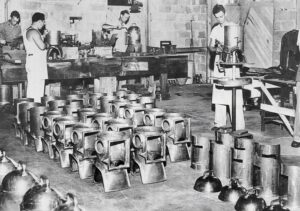
Capt. William S Dunn

William F. Miller

DUNN DIVINHOOD
Captain William S. Dunn began designing his helmet after his boat suffered some damage to its rudder. Dunn spent 3 years developing and perfecting his helmet and in 1916, the Dunn Divinhood came to market, a simple and easy to use open-bottom helmet made of sheet copper.
The price of this outfit (including helmet, weights, pump, and hose) in 1916 was only $75, and by 1918 the price had risen to $100 and for an extra $85 a telephone would be fitted inside the helmet.
Patent





Design
The helmet is a cylinder with a domed top made out of sheet copper and rolled edges on the bottom. The glass is in a 6 inch round brass frame, with a leather or rubber gasket, that securely fitted to the front of the helmet. A threaded brass elbow is fixed to the right side of the hood, pointing down, in order to connect an air/garden hose. Copper strips were riveted to the front and back of the hat, in order to secure 4 lead weights, in which gravity held in place. These weights would hold the helmet firmly down onto the diver’s shoulders by overcoming the buoyancy of the air filled hat in the water.
Pictures from the Past







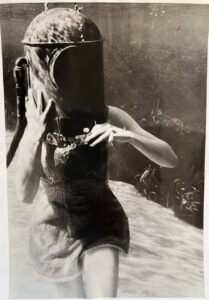

MILLER-DUNN style 2 DIVINHOOD
Style 2 DIVINHOOD
Patented August 10, 1926 and was the 1st to be labeled as the Navy Standard. This helmet was made famous due to scientists such as Mayor, Bebee, and Longley in their study of submarine life.
In 1927, the complete cost of this outfit (helmet, weights, pump, and hose) cost only $250 and by 1934 the price had risen to $300.
Patent





Design
The helmet has a similar shape and method of construction as it’s predecessor. A copper helmet having 2 large, broad face plates, comfortable flanges on the shoulders, air deflectors guiding the air forward against the face plates, thereby preventing fog from forming when in cool water; 4 lead weights, heavy enough to allow to allow the diver to walk on the bottom without excess pressure on the shoulders.
The 2 front glasses give such a wide range of vision that there is no blind spot. The windows are set angled in a large brass frame protected by 2 cross bars. The frames are so constructed that 1 glass can be replaced without disturbing the other. The plate glass ports are set in soft cotton wicking soaked with thick, white lead, making a waterproof joint that can easily be replaced.
A copper baffle flat has been placed inside the helmet in order to direct the air flow over the glass to help prevent it from fogging up.
The air elbow is now angled slightly backwards in order to help form a loop in the air hose. This made it so that any pull on the hose wouldn’t lift the hat off the diver’s shoulders.
The lower part of the helmet now bulges outwards to fit the diver better and improve stability. The shoulder area has been widened, spreading the weight and making it more comfortable. The bottom of the hat has been squared off making it possible for it to stand on its own.
Pictures from the Past
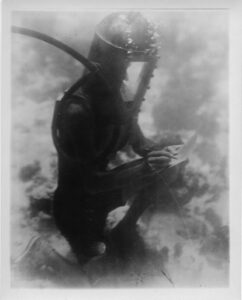






MILLER-DUNN style 3 DIVINHOOD
Style 3 DIVINHOOD
Patented August 23, 1937 this is the third and final shallow water helmet that Miller Dunn produced. This helmet is famous today partly due to Art Mckee, a well-known treasure diver, for salvaging the many Spanish gallions wrecked off the Florida keys.
The complete cost of this outfit (helmet, weights, pump, and hose) in 1940 was only $250.
Patent

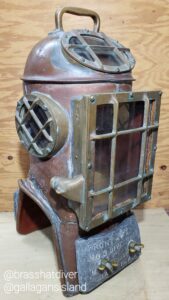





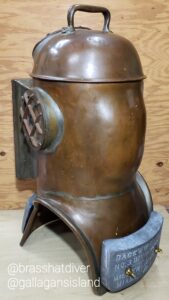

Design
A copper helmet with 2 lead weights, heavy enough to allow the diver to walk on the bottom without excess pressure on the shoulders.
The front window is a large, flat, clear glass, causing no distortion, allowing precision work with the cutting torch or picture camera. there are windows on both sides and top. Besides having a full view of the work at hand, side windows make turning the entire body unnecessary, and the top window offers a view of the boat or dock from which the diver is working. Duplate safety glass, amply protected by bronze grating, is used on all 4 windows.
A “bulge” following the general contour of the head has been placed in the back for greater comfort. This recess allows sufficient room to tilt the head backward for complete vision through the top window, and freedom from draft from the air inlet.
Another structural improvement is the enlarged contour roll which allows a snug, comfortable fit on the shoulders. This roll is also designed for added strength to the lower part of the DIVINHOOD and will stand rough usage.
Air enters the helmet on the lower side and is guided by a deflector to the front window. Fogging and draft have been reduced to a minimum, and the position of the inlet forms an air safety chamber in case of a cut or loosened hose.
The 4 hook-on weights were now replaced by 2 weights (1 on the front and 1 on the back) shaped to fit closely to the helmet and are secured by large bolts and wing nuts
Pictures from the Past
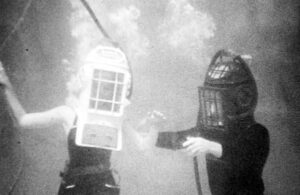





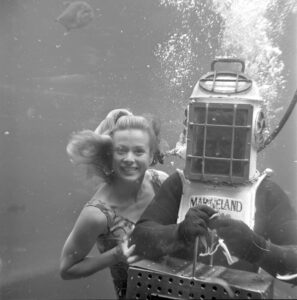

Weights




Pumps
The Miller Dunn No. 2 pump
Identical to the No. 1A pump, except for newly designed covers. These caps would help to keep dust, dirt, and rain water out of the cylinders.
Only 3 examples are known to the author at this time.

